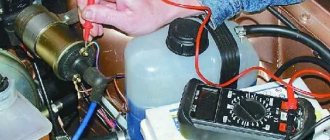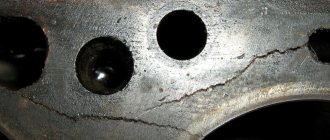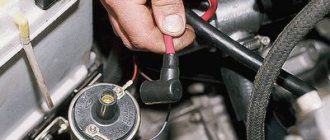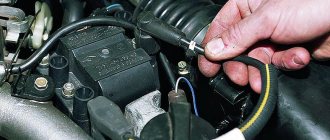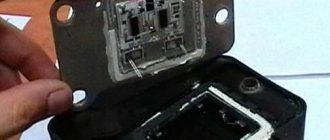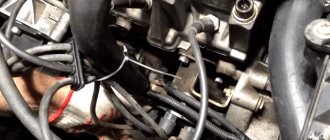The abundance of monitoring and control electronics still does not allow protecting modern injection engines from various malfunctions and problems. Periodically, the engine idles unstable, starts poorly and does not allow you to move away.
You should not always rely solely on electronics, sensors and the car's on-board computer. If, the next time you try to start the internal combustion engine, you clearly hear the fuel pump (pump) working, but the engine itself does not start, you need to check your ignition system to ensure its functionality.
Practice clearly shows that quite often the reason lies in the lack of a spark on the spark plugs. It is with their inspection that experienced motorists and repairmen recommend starting the inspection. Only when deciding to deal with the problem on your own, be extremely careful. There are several methods for checking spark, but each of them requires mandatory compliance with safety rules. Otherwise, you may suffer from an electric shock, as well as damage the car itself.
Causes of spark loss
Before checking the spark on your injection or carburetor engine, you need to figure out why this spark may disappear and where you should look first, trying not to damage the engine itself.
Depending on the specific type of internal combustion engine used in a car, there are several main factors that cause the lack of a high-quality working spark in the spark plugs. But often this is directly related to:
- discharged battery;
- damaged or failed spark plugs;
- filling spark plugs with fuel or oil;
- faulty module, coil or switch;
- poor contact of the insulation itself or damage to some high-voltage wires;
- faulty crankshaft position sensor;
- a failed distributor;
- poor quality of contact with ground;
- problems directly in the low voltage circuit itself;
- faulty control electronic unit.
Experienced motorists advise starting the check with the most banal, but at the same time quite common reason. Namely from the battery. The battery could simply be discharged, making it impossible to start the engine.
If, when you turn the key in the ignition, you see the icons on the dashboard shining very dimly, then the battery is probably dead. Solving such a problem is not difficult. If the battery is drained, it will need to be charged or completely replaced with a new battery.
Also, a problem with the operation of the system may lie in terminals that are oxidized or corroded. It is necessary to clean them, tighten them tightly and treat them with high-quality graphite lubricant. This treatment will prevent re-oxidation.
Verification methods
If there is no spark, you can use several self-diagnosis methods. The procedures are performed as follows:
- checking for weight;
- multimeter;
- arrester (tester with piezoelectric element).
In the case of the first method, which involves checking for weight, it is strongly recommended to use it exclusively on carburetor types of internal combustion engines. You need to take the spark plug and carefully bring it to any suitable metal component of the engine. Usually brought to the cylinder block. At the same time, the assistant should try to start the engine by turning the key in the lock. This allows you to determine which spark plug is being supplied.
But it is strongly not recommended to use this method on injection engines, since there is a high risk of damaging the electrics and expensive electronics.
If you use a multimeter, you can check the spark plugs themselves. There is nothing complicated in diagnostics, but there are no threats to the ECU. The check is carried out according to the same principle as in the first case.
Another option is to use a spark gap. This method is also suitable for carburetor types of engines. Such a tester allows you to find out exactly where in the ignition system of your car such problems have arisen.
When there is no spark in all working cylinders, the culprit is the controller, the coil, or the ignition module itself, as well as the central electrical wire. Here you should start by checking the important fuses. Next, the mass and current condition of the high-voltage wires are checked.
If there is no spark on the coil itself, then you need to check the central power wire. If breakdowns, insulation failure and other damage are detected there, they should be immediately eliminated by replacement.
Don't forget to check the spark plugs themselves. This is important to do in a situation where it has been established that the spark definitely reaches them, but still does not form. It is also important to take into account what color the spark is. Normally it is white with a slight blue tint. If there is a weak spark, you need to check the contacts.
The most universal tip is to always have a set of spare candles on hand. They can come in handy at any time.
It is necessary to separately consider the procedures for checking the spark on the coil, the spark plugs themselves, and the module used in the ignition system.
Why can't we ignore this?
Let's start with the ignition coils. When a spark is not produced, a voltage surge occurs in the coil. The difference may be so big that the coil will simply burn out. It’s good if it’s an old engine, where each cylinder has its own coil - I bought one and changed it. But if there is a single cassette, as happens on some Citroens and Opels (all Saabs), repairs will be very expensive.
Go ahead. Detonation. Unburned gasoline accumulates in the combustion chamber and at one point begins to spontaneously ignite under the critical pressure of the piston. Everything suffers - pistons, rings, cylinder walls, liners. If the engine experiences detonation, repairs are inevitable. And a lot will have to change...
Please note: if there is a crack on one of the spark plug insulators, it means that the engine has already caught detonation.
Crack in the spark plug insulator
Coil
In the case of the coil, it can be characterized as a fairly reliable and durable element of the ignition system. It rarely fails and causes trouble for the car owner. But sometimes problems appear and need to be fixed.
Most often, problems with the coil are caused by damage to the winding itself. If this happens, a breakdown occurs in the insulation, which can cause a short circuit that is dangerous for injection engines.
Another reason for damage to the coil is considered to be overload caused by malfunctioning spark plugs or damage to the high-voltage wiring (high-voltage wires).
Before you start checking the spark on the coil, be sure to make sure that the room where the diagnostic work is being carried out is dry. You can do the test yourself, and no special devices or professional equipment are required.
Diagnostics is carried out according to a standard scheme, which involves performing several sequential procedures:
- Thoroughly clean the distributor cover from accumulated dirt. Only after this can it be opened and removed;
- After turning the engine crankshaft, it is necessary to close the distributor contacts;
- The ignition is turned on;
- The high-voltage wire coming from the distributor is brought to the ground of the car. It is important to ensure a distance of 5 mm;
- To increase the accuracy of the test, it is periodically necessary to manually open the distributor contacts.
Selection by model
- Chainsaws
- Spare parts for Chinese chainsaw 45, 52 cc. Cm
- Spare parts for Chinese chainsaws 38 cc.
- Spare parts for Chinese chainsaw 25 cc.
- Spare parts of Chinese Calm 660
- Spare parts for partners 350, 351, 352, 371
- Spare parts for partners 340S, 350S, 360S
- Spare parts for Husqvarna 137, 142
- Spare parts for Husqvarna 230, 235, 236, 240
- Spare parts for Husqvarna 365, 372
- Spare parts for Calm 180
- Spare parts for Calm 210, 230, 250
- Spare parts for Calm 290
- Spare parts for Cali 361
- Trimmers
- Spare parts for Chinese trimmer 33, 43, 52 cc
- Spare parts for Chinese trimmer 26 cm3.
- Spare parts for Husqvarna 125, 128
- Spare parts for Champion T283, T284
How to make a start button instead of an ignition key in a car with your own hands. How to connect the starter
Candles
There is another option, how you can check for the presence of a spark on the injector yourself by testing the spark plugs themselves. It happens that the ignition system distributor is in fully working condition, but for some reason a spark still does not appear on the spark plug itself.
But before you check the spark yourself, make sure that the fuel mixture is entering the injector and there are no problems with the air filter clogging.
Diagnosing sparks on candles is not a complicated or time-consuming procedure. You can even do it yourself, without outside help.
- First, check the current condition of the wires that go to the spark plugs from the distributor. If you notice insulation problems, there is probably a problem with the wiring;
- Then remove all the spark plugs with a special tool. Check their condition, assess the amount of accumulated carbon deposits. If there is one, it is recommended to clean it and get rid of dirt;
- Check the distance between the electrodes. Normally it is from 0.7 to 0.9 millimeters. If the distance is different, you can simply try to bend or bend the electrode to the desired value. But this is an old method that is advised to be abandoned;
- There is another option. It consists of replacing the spark plugs with new, better quality and more durable ones. Here, iridium elements perform well;
- Having dismantled all the candles, combine them into one row, connecting them using steel wire;
- One end of the wire remains long for further grounding to ground;
- Having secured it to ground, you need to turn the starter while watching the spark plugs;
- If a spark does not form at all, or it is dim, very weak, then the switch is probably out of order.
It also happens that sparks of varying intensity are formed. There may be the following reasons:
- the wires going to the spark plugs are damaged;
- the distributor runner is damaged or worn out;
- the wires are poorly connected to the spark plugs;
- There is damage in the spark plugs themselves.
As you can clearly see, there is nothing difficult in checking candles. This work is performed in 30-50 minutes in a garage without the use of any diagnostic stands, special measuring instruments or professional tools.
Conclusion
You can simplify the work with spark plugs by following a simple recommendation - change spark plugs according to schedule and service life. This is usually about 30 thousand km for gasoline internal combustion engines.
One of the methods for checking candles on video.
General recommendations for using candles.
When problems with spark plugs appear in cars, this immediately affects the normal operation of the engine, friction appears, and the engine stalls. You can find out whether the problem is really with the spark plugs by externally assessing their condition and checking whether there is a spark.
Checking the spark on the ignition module
Experienced and fairly experienced drivers know that engine tripping and problematic engine starting are often associated with a spark. Or rather, its absence on the spark plugs.
Therefore, every owner of a vehicle with an injection engine must know how the test is carried out even in extreme field conditions. The most correct decision would be to buy new high-quality spark plugs, which are always in the car’s glove compartment as a set.
When removing high-voltage wires from the module, it is recommended to first apply serial numbers to them with a marker. This will prevent you from getting confused during the reassembly process.
If everything is fine with the spark plugs, and the wires are also intact, the cause of the malfunction is probably in the module. To make sure of this for sure, you can use the substitution method. That is, in place of the probably faulty module, another module is installed, intended for a car of the same make and model. If the check shows that your module has failed, since everything works fine with the new one, all that remains is to purchase a new device.
When working with high voltages, spark plugs and the module, be sure to use tools that have insulated handles. Additionally, it is recommended to keep a set of dielectric gloves on hand.
To blame the ignition module for everything, you must have the appropriate grounds. There are several manifestations or signs of malfunctions that are characteristic of an injection engine in case of problems with this module. Here we are talking about the following symptoms:
- there is intermittent operation of the power plant when the engine is idling;
- power drops noticeably;
- the power deficit is especially pronounced when the driver tries to accelerate sharply;
- cylinders located next to each other do not work correctly.
Also, while driving, a warning light may light up on the dashboard indicating the need to check the engine.
If one or several of the symptoms mentioned appear in practice during the operation of your vehicle, you should be wary and mentally prepare yourself for the fact that in the near future you will have to spend a fairly substantial amount of money. The new module is not that cheap, so motorists cannot rejoice even if they managed to discover the source of the trouble, and it turned out to be the ignition module.
https://www.youtube.com/watch?v=ZFJTiLZWSu0
It is recommended to start diagnosing the module only if you have definitely ruled out all other possible reasons for the lack of a spark in the ignition system.
In this situation, the most informative, but at the same time quite simple check of the spark on the injector is to use a tester. One probe goes directly to the contact, which is marked with the letter A on the ignition module connector, and the second probe is connected to ground. Next, the engine is started by turning the key in the ignition switch.
If, when starting the engine, the voltmeter or multimeter in voltmeter mode shows a value of 12 Volts, then we can talk about the serviceable and working condition of the ignition module. That is, there is no need to change it or repair it.
How to identify faults
It is not so difficult to determine the performance of the SZ on your own - this can be done both by visual inspection and by analyzing the performance of the engine. One of the main symptoms of an SZ failure is non-standard engine operation. In particular, we are talking about the difficult start of the power unit, its unstable operation, in particular at idle speed.
But besides these symptoms, there are many other signs, which are given below:
- In particular, we are talking about the rotation of the crankshaft. The crankshaft rotates at the required frequency, but the power unit does not start because ignition, i.e., ignition of the air mixture, does not occur in the system.
- Presence of flashes in the cylinders. If flashes of the air-fuel mixture occur in the cylinders, this can lead to unstable engine operation. In particular, the internal combustion engine will work intermittently.
- Poor engine starting. In principle, the engine can start, but if the starter stops working, the engine also stops.
- Increased gasoline consumption. If there is no ignition of the air-fuel mixture, then engine power is either reduced or completely lost. Accordingly, compensation of engine power is carried out as a result of supplying an increased portion of fuel to the cylinders. Ultimately, this leads to excessive fuel consumption.
- Failure of the catalyst. If the system does not ignite, the air-fuel mixture will not be able to ignite. Fuel that does not ignite will enter the catalyst and oxidize, thus contributing to its failure.
- Problems starting a cold engine. At the moment when the driver turns the key in the ignition switch, cold SZ can collect condensation, which in itself is a good electrical conductor. If the gap between the SZ electrodes is increased, the breakdown voltage level should be increased. However, at home it is impossible to increase it, since electricity will flow through these same electrodes and ceramic cone.
- Another, no less important sign is the presence of traces of mechanical damage on the surface of the spark plug. This indicates, if not a complete breakdown, then at least incorrect operation of the SZ, which over time can lead to its failure.
- Presence of soot and deposits on the SZ electrodes. In addition, if the SZ smells of fuel, this indicates a malfunction of the system itself, as well as the spark plugs.
- High-voltage cables on the NW can also contribute to the deterioration of engine performance. Especially if these wires are damaged.
Two SZ - with and without plaque
Checking the Low Voltage Circuit Condition
This is also not a superfluous event when it comes to the absence of a spark on the candles. To carry out such a diagnosis, you will need a test lamp. Moreover, choose a device with a power of 2-3 W and a voltage of 12 V.
One contact from the control unit is connected to the low voltage contact of your distributor, and the second goes directly to ground. Now you need to close the distributor contacts and start the ignition. If there are no problems in the circuit, then at the moment the contact closes, the lamp must go out. In this case, it lights up only when the contacts open.
If, after opening the distributor contacts, nothing happened, that is, the control lamp did not light up, the cause of the malfunction most likely lies in the breakdown of the primary winding of the coil, or in the low voltage wires.
There are situations when the control lamp shines constantly during diagnostics, without interruption, regardless of the opening or closing of the contacts. Here you should consider one of several potential reasons for this behavior of the warning light:
- the contacts on the distributor have oxidized, which need to be frequented and, if possible, lubricated with graphite lubricant;
- the wires that connect the movable disk of the distributor and its body are damaged;
- other wiring located between the distributor terminal and the lever was damaged.
The test should always be carried out in stages, starting from the most likely faults, and ending with those that are much less likely to cause a lack of spark.
Do not rush to make the worst and most unpleasant diagnosis for your ignition system. It often happens that the reason lies in banal carbon deposits on spark plugs or blown fuses.
Useful tips
Experienced drivers know very well that spark plugs fail precisely at that moment, which can rightly be called the most inopportune.
To avoid problems, carry out all diagnostic and repair work correctly, follow a few simple rules. There are a number of useful tips on this matter:
- Always have candles with you. This is the golden rule for any motorist. For cars there is a certain set of mandatory items that you should always have with you. These are a jack, a spare tire, antifreeze, etc. These definitely include spark plugs. A spare kit should always be on hand;
- Don't forget the wires. The same goes for spark plug wires. Carry a set of them along with the candles themselves, keep them in the glove compartment, but it’s better not to leave them open somewhere in the luggage compartment. High humidity can cause them to wear out even before you try to install these wires in place of the damaged ones. The same can be applied to the candles themselves, the best place for which is considered to be the glove compartment;
- Isolated instruments only. This is a special tool for motorists, which is distinguished by the presence of insulated handles. Under no circumstances use the same screwdrivers with wooden, plastic, or even metal handles. Only special insulating coating. This will prevent severe electric shocks. After all, working with candles involves a fairly large threat, since high-voltage wires pass there;
- Known good ignition module. To minimize the time required to carry out diagnostic activities, as well as speed up the search for the culprit in the absence of a spark on the spark plugs, simply use a working module. You can borrow it from passing motorists. Or just keep a spare module in your car in case of an emergency. By replacing it with the old one and making sure that the ignition system is working again, you will quickly solve the problem;
- First of all, the candles themselves. Statistics and the practice of motorists clearly show that the cause of the lack of a spark is most often the faulty spark plug itself; diagnostics should begin with this element. And then move on to the remaining components of the ignition system if the spark plugs are in good condition;
- Maintain the order. Don't rush to unscrew all the spark plugs at once. Surely only one of them does not work. Therefore, dismantle them one by one, put a cap and a coil wire on the spark plug, and then ground it to ground;
- Quality and intensity. When rotating the starter, look not just at the presence or absence of a spark, but at its quality. A weak spark may be present, but it is unable to cope with the task assigned to it. Therefore it is considered faulty. It needs to be restored or simply replaced;
- Wire markings. If it comes to the need to remove the wires from the spark plugs from the ignition module, it is recommended to mark them for personal safety. This way you will definitely check everything correctly, and then you can connect everything according to the established order. After all, if you mix up the wires, you can face quite unpleasant consequences. You should not take risks and rely entirely on your memory. It won't take you long to mark.
It cannot be said that diagnosing the state of the ignition system when there is no spark on the candles is very difficult. The motorist can carry out almost all of the procedures described above with his own hands.
By following certain rules, actions in a given sequence and not forgetting about your own safety, you will spend a minimum of time, gain experience in servicing your car yourself, and will also be able to save a lot on car service services. This is not the case when it is necessary to contact specialists.
Diagnostics without instruments
How to check the spark plugs yourself if you don’t have the necessary testers? Everyone can do this. There is a proven method. But you need an assistant. To do this, unscrew the spark plug and put the high-voltage wire back on it. An assistant turns the starter. At this time, we direct one part of the spark plug to ground - we lean it against any metal part of the engine. It is important that there is no paint on it, otherwise contact will not occur. The spark should be blue.



